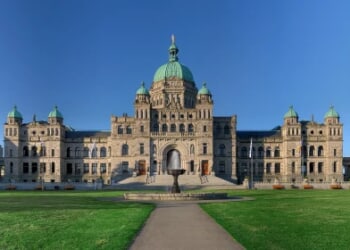USS George Washington (CVN-73) was the sixth carrier in the Nimitz-class to enter service with the Navy.
USS George Washington arrived in Busan for a scheduled port call earlier this month, eliciting protests from North Korea. The flagship of Carrier Strike Group 5 (CSG 5) demonstrated the US-South Korean security relationship when it passed through on November 9. While the vision of maintaining a free and open Indo-Pacific remains a top goal for the United States and its East Asian ally, Pyongyang was not pleased with the visit. North Korean defense minister No Kwang Chol protested the scheduled port call altogether, claiming it enflamed existing military and political tensions on the peninsula.
“Amid the ongoing U.S.-ROK joint air drill Freedom Flag, the appearance of the super-large nuclear carrier George Washington task force belonging to the U.S. Seventh Fleet heralds the critical excess, further escalating the tension on the Korean peninsula,” No proclaimed in a statement. The North Korean official also criticized US defense secretary Pete Hegseth’s visit to the demilitarized zone between North and South Korea, stating it was essentially to escalate “war hysteria.” Tensions between Beijing and its regional allies and the United States and its Indo-Pacific partners have risen dramatically in recent years. USS George Washington’s presence in the region demonstrates the US military’s ability to project power overseas.
Introducing the Nimitz-class
USS George Washington (CVN-73) was the sixth carrier in the Nimitz-class to enter service with the Navy. Named to honor the Founding Father and commander-in-chief of the Continental Army during the Revolutionary War, George Washington has certainly lived up to its namesake. The massive carrier was commissioned at Naval Air Station Norfolk in 1992 and will continue to sail until the end of her service life sometime around the 2040s. Notably, George Washington became the first-ever nuclear-powered aircraft carrier to be forward-deployed at naval base Yokosuka, Japan, back in 2008.
Like its sister ships, George Washington is considered to be one of the most advanced supercarriers of its kind out at sea today. The Nimitz ships all run on a pair of A4W pressurized water reactors, which provide a top speed for the boats of over 30 knots. More importantly, the Nimitz’s nuclear power enables the class to remain at sea for over two decades without requiring refueling. When it comes to aerial projection capabilities, George Washington and its sister ships are nearly unbeatable. The angled flight decks featured on these carriers all use a CATOBAR arrangement, which allows for efficient launch and recovery operations. In addition to airframes, the newer Nimitz-class carriers feature three Raytheon GMLS Mk-29 eight-cell launchers for NATO Sea Sparrow surface-to-air missiles, among other close-in weapons systems.
While USS George Washington is not decommissioning anytime soon, when it does, its replacement will be even more capable. The Navy is currently working on fielding its latest Ford supercarrier class of warships. The lead ship of the class, USS Gerald R. Ford, remains the only carrier in commission to date, but will be followed by other Nimitz replacements steadily over the next couple of decades.
About the Author: Maya Carlin
Maya Carlin, National Security Writer with The National Interest, is an analyst with the Center for Security Policy and a former Anna Sobol Levy Fellow at IDC Herzliya in Israel. She has by-lines in many publications, including The National Interest, Jerusalem Post, and Times of Israel. You can follow her on Twitter: @MayaCarlin. Carlin has over 1,000 articles published over the last several years on various defense issues.
Image: DVIDS.

















